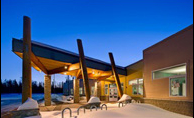
by Shane Henson — October 5, 2011—Marysville Getchell High School Campus in Marysville, Washington captured the 2011 James D. MacConnell Award at the Council of Educational Facility Planners International (CEFPI)] Annual Conference & Expo held at the Gaylord Opryland Resort in Nashville, Tennessee. The James D. MacConnell Award recognizes the importance of a comprehensive planning process resulting in educational facilities that meet multiple goals, while serving the needs of the community.
According to educational facility planner Amy Yurko, AIA, CEFPI 2011 Planner of the Year, embedded in the process for planning and designing Marysville Getchell High School Campus was an understanding of what students need to be successful in their educational careers as well as throughout their lives. These needs stretch across physical, social/emotional, and developmental aspects of each individual learner and tie them together in new and exciting ways.
Through the collaborative and inclusive planning process, the range of learner needs were translated into the student groupings and activities required and then translated again into the physical settings where these activities are supported. The resulting design of the Marysville Getchell Campus is beautiful, dynamic, flexible and supportive of teaching and learning, but perhaps more important, the new campus is transforming the lives of students in Marysville, says Yurko.
Through learning more about how the design of Marysville Getchell High School Campus has benefited students and teachers, facilities managers working in educational settings may be able to better promote teaching and learning in their own facilities. They may also be able to take notes from the 2011 MacConnell Award finalists:
Blue Valley Center for Advanced Professional Studies: The Center for Advanced Professional Studies (CAPS) provides 600 Blue Valley high school juniors and seniors from five district schools with a unique learning opportunity for hands-on, real world experience in a professional interest area of their choice.
Helen M. Knight Elementary: The New Helen M. Knight Elementary School in Moab, Utah is a school that was designed after an extensive community engagement process. The 800-900 student elementary school replaces two outdated schools and was constructed on open space on the site of one of the existing schools. It reportedly reflects the best in elementary learning communities, exceptional learning environments, and sustainable design in a regionally appropriate aesthetic utilizing local materials and color palette.

Su Valley Jr./Sr. High School: Following the destruction of the old school by fire in June 2007, the Mat Su Borough acted decisively to meet community needs. Prior to fall semester, a temporary facility was established and a planning team was in place to design the new school. With less than two months to explore new directions, create an educational specification, and develop a concept design, the project team adopted an integrated approach combining concept design activities with visioning exercises in a series of interactive user-driven workshops. Breaking from the usual linear progression, this process created unique opportunities and insights as design and program discussions evolved on parallel tracks. The more than 200 participants included a broad range of school and community partners and every student in the school.





